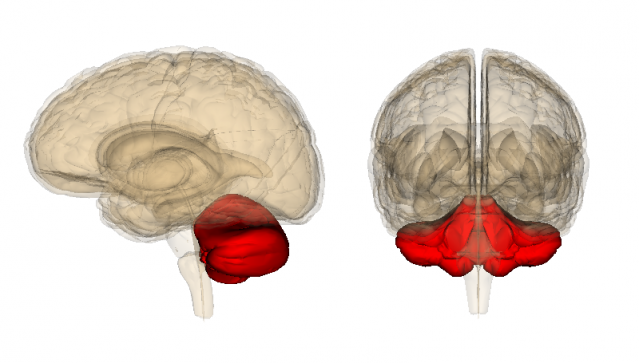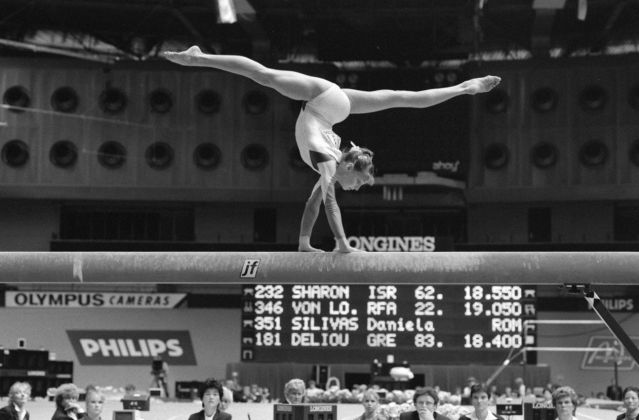Neuroscience
How Does Your Cerebellum Counteract "Paralysis by Analysis"?
The cerebellum "expects the unexpected" and can override cerebral thinking.
Posted August 4, 2015

For over a decade, I've had my antennae up for any new research on the cerebellum. I'm constantly striving to connect the dots on how the cerebrum and cerebellum are interconnected both structurally and functionally. In recent months, a wide range of groundbreaking studies on the cerebellum have been released. In this blog post, I'll explore the latest findings on the cerebellum from McGill University in Canada.
My father, Richard Bergland, was a neurosurgeon, neuroscientist, nationally ranked tennis player, and the author of The Fabric of Mind. My dad was obsessed with the cerebellum in sport and in life. He passed this obsession on to me.

My father often said, "Of this I am absolutely certain, becoming a neurosurgeon was a direct consequence of my eye for the ball." His first hand experience of the power of the cerebellum's vestibular system to track a moving target (such as a tennis ball), and to create superfluid muscular coordination in sport and in the operating room was lifechanging for him.
My dad understood the power of the cerebellum long before most of his contemporaries. Much of the latest research on the cerebellum has confirmed what my father hypothesized about the mysterious and powerful "little brain" intuitively, and intellectually, long ago.
Since the beginning, The Athlete's Way has been built around a split-brain model that seats the executive function of sports in the cerebrum, and the automatic skills, and muscle memory of performance in the cerebellum. On p. 12, I write:
My dad has always been obsessed with the Purkinje cells of the cerebellum, and their ability to hold muscle memory. When I was a kid playing tennis every day, his words echoed in my mind. "Carve the grooves into the cerebellum, Chris. Think about hammering and forging your muscle memory with every stroke."
The Cerebellum Is the Seat of Automatic Motor Skills and Muscle Memory
I decided when I signed a book deal with St. Martin's Press that I was going to use that platform to advance my father's ideas about the cerebellum. My father and I spoke daily as I was writing The Athlete's Way manuscript over a decade ago.

In the 1970s, my father was praised and put on a pedestal by his peers and mainstream media for advancing the traditional split-brain model of "left brain-right brain" to a general audience. Among other accolades, my dad was the leading neuroscientific expert for Betty Edwards' best-selling book, Drawing on the Right Side of the Brain.
My dad was an iconoclast who pushed against neuroscience status quos. When he tried to shift the conversation away from the "left brain-right brain" model and put the cerebellum in the spotlight—he was labeled a heretic and charlatan by both his colleagues at Ivy League medical schools and other peers.
As a scientist, my father grew frustrated by the constraints of 20th century brain imaging technology to prove his visionary ideas about the cerebellum in a laboratory. I always had a hunch that my dad was right about the cerebellum. On p. 82 of The Athlete's Way I describe my inherited passion for the cerebellum,
Although the cerebellum is only 10 percent of the entire brain, it contains more than half of all of the neurons in the brain. Measured by neurons, rather than volume, 'the little brain' is actually the larger brain. Whatever the cerebellum is doing, it is doing a lot of it. Never underestimate the power of the cerebellum.
Cerebellar means relating to or located in the cerebellum. This is the sister word to cerebral, which means of or located in the cerebrum. I believe cerebellar should be a household word just like cerebral, because it is equally important. Being equally cerebellar and cerebral is the key to fluid athletic performance.
I am on a crusade to make people aware of their cerebral and cerebellar thinking. I am a champion for the underdog, and the cerebellum has been one for too long. I want to get you thinking about your cerebellum to help you create athletic genius so you can play like a champion.
In 2007, just a few weeks after The Athlete's Way was published, my father died. I was devastated. I made a vow at his funeral that I would do everything in my power to keep his passion for the cerebellum alive.
Every morning, I wake up hoping there will be new research to advance our understanding of the cerebellum. I'm on a mission to vindicate my dad, prove that he was ahead of his time, and communicate his ideas about the cerebellum to a new generation.
Individual Neurons in the Cerebellum Can Learn Motor Skills
Earlier today, I was thrilled to read a new study from McGill University which discovered that a surprisingly small cluster of brain cells deep within the cerebellum allows athletes to learn new motor skills—such as how to serve a tennis ball, hit a baseball, perform gymnastics on a balance beam, etc.
The August 2015 study, "Learning to Expect the Unexpected: Rapid Updating in Primate Cerebellum During Voluntary Self-Motion," was published in the journal Nature Neuroscience. It's studies like this that bring my father's ideas about the cerebellum into the 21st century.
Tennis legend Arthur Ashe said famously, "There is a syndrome in sports called 'paralysis by analysis.'" In my opinion, when the cerebrum is overthinking, and the cerebellum is disengaged, "flow" is inhibited and an athlete chokes. I believe this new research confirms that the cerebellum may be at the heart of breaking the vicious cycle of paralysis by analysis by 'unclamping' the cerebrum from overthinking during sports.
The new study was led by Kathleen Cullen from the Department of Physiology at McGill. The focus of her lab's research is to understand the mechanisms by which self motion (vestibular) information is encoded and then integrated with signals from other modalities to ensure accurate perception and control of gaze, movement, and posture.
Cullen points out that self-motion is automatically sensed by the vestibular system including key regions of the cerebellum, which contributes to an impressive range of brain functions, from the most automatic reflexes to complex spatial perception and fine-tuned motor coordination, such as those used for gymnastics.

In the latest experiment from McGill, Cullen et al discovered that in order to learn a new motor skill, a small number of neurons within the cerebellum engage in elegant, virtually mathematical, computations in which they quickly compare expected feedback with the actual sensory feedback in real-time.
The study was conducted by carrying out a trial-by-trial analysis of the responses of brain activity of single cerebellar neurons in macaque monkeys who were engaged in performing specific movement learning tasks.
This research shows that cerebellar neurons are able to instantaneously readjust by changing the strength of connections between other neurons to form new patterns in the brain in order to fluidly accomplish the task at hand. In a press release, Cullen described the research saying:
We've known for some time that the cerebellum is the part of the brain that takes in sensory information and then causes us to move or react in appropriate ways.
What we didn't know until now is that single neurons in our brain manage to dynamically track the difference between what the brain expects to take in from the senses and the information it is actually receiving during motor learning. Our research shows that this calculated difference (i.e., "sensory prediction error" signal) is used to rapidly change the patterns and connections between neurons in order to learn new motor skills.
In order to learn a new motor skill, the researchers found that the cerebellum makes an estimate of the expected sensory inflow that it should get from your sensory system. Then, the cerebellum automatically uses this prediction to compute the difference between what you intended to do and what you actually did. This cerebellar process is key to creating flow and achieving what I call "superfluidity" both on and off the court.
These new findings further suggest that through practice, elite level athletes become better at coordinating their movements and understanding their own proprioception. Through practice and repetition, the cerebellum also gets better at predicting the unexpected and making lightning fast corrections and readjustments necessary for peak performance.
Conclusion: Optimizing Cerebellar Function Has Benefits in Life and Sport

The cerebellum plays a vital role in motor learning by constructing an estimate of the exact sensory consequences of a specific movement. The new findings from McGill demonstrate the incredible sophistication of the cerebellar computations needed to automatically learn how to expect unexpected sensory inputs and adapt accordingly.
Cullen concluded, "A gymnast doing a backflip on a balance beam depends on this ability to precisely compute the mismatch between where they expect to land and where they actually find themselves in order to land squarely on the beam. But the research is equally relevant to stroke and multiple sclerosis patients and to the clinicians who treat them."
If you'd like to read more on the cerebellum, check out my Psychology Today posts:
- "Why Does Overthinking Cause Athletes to Choke?"
- "Toward a New Split-Brain Model: Up Brain-Down Brain"
- "Neuroscientists Discover How Practice Makes Perfect"
- "The Neuroscience of Knowing Without Knowing"
- "The Brain Mechanics of Rumination and Repetitive Thinking"
- "Want to Improve Your Cognitive Abilities? Go Climb a Tree!"
- "The Wacky Neuroscience of Forgetting How to Ride a Bicycle"
- "The Mysterious Neuroscience of Learning Automatic Skills"
- "The Neuroscience of Making Eye Contact"
- "12 Ways Eye Movements Give Away Your Secrets"
- "The Neurobiology of Grace Under Pressure"
- "The Neuroscience of Imagination"
- "Why Does Walking Stimulate Creative Thinking?"
- "The Cerebellum May Be the Seat of Creativity"
- "The "Right Brain" Is Not the Only Source of Creativity"
- "Better Motor Skills Linked to Higher Academic Scores"
- "Hand-Eye Coordination Improves Cognitive and Social Skills"
- "The Cerebellum Deeply Influences Our Thoughts and Emotions"
- "Why Do Drunk People Stumble, Fumble, and Slur Their Words"
- “The Cerebellum, Cerebral Cortex, and Autism Are Intertwined”
- "How Is the Cerebellum Linked to Autism Spectrum Disorders?"
- "Research Links Autism Severity With Motor Skill Deficiencies"
- "The Neuroscience of Calming a Baby"
- "How Are Purkinje Cells in the Cerebellum Linked to Autism?"
- "Autism, Purkinje Cells and the Cerebellum Are Intertwined"
- "How Does Body Posture Affect Early Learning and Memory?"
- "The Cerebellum Holds Many Clues for Creating Humanoid Robots"
- "Childhood Family Problems Can Stunt Brain Development"
- "Is Cerebellum Size Linked to Human Intelligence?"
- "Primitive Brain Area Linked to Human Intelligence"
- "How Does the Vagus Nerve Convey Gut Instincts to the Brain?"
- “Why Is Dancing So Good For Your Brain?”
- “The Neuroscience of Madonna’s Enduring Success”
- "Adding Movement to a Mental Rehearsal Improves Performance"
- "No. 1 Reason Practice Makes Perfect"
- "How Does Practice Hardwire Long-Term Muscle Memory?"
- "5 Neuroscience Based Ways to Clear Your Mind"
© 2015 Christopher Bergland. All rights reserved.
Follow me on Twitter @ckbergland for updates on The Athlete's Way blog posts.
The Athlete’s Way ® is a registered trademark of Christopher Bergland.




